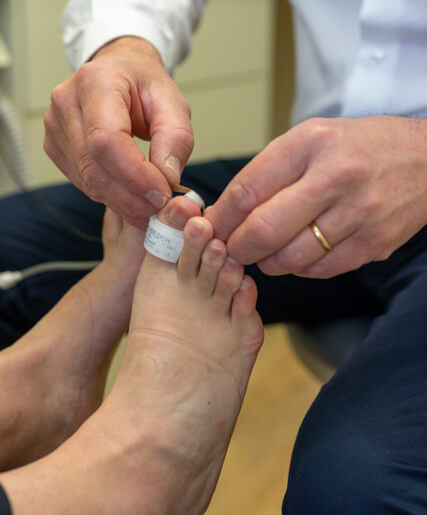Foot and Lower Limb Pain Treatment
An issue with any of the joints or muscles in the lower limb can have a direct effect on your feet.
Heel Pain and Plantar Fasciitis Treatment
This is an inflammation and change of the thick fibrous band of tissue which runs from the heel to the base of the toes.
Feet Running Injury Treatment
These include calf injuries, Achilles tendonitis, shin splints, knee and ITB pain and general heel, foot, and ankle pain.
Children’s Foot Pain Treatment
Healthy, happy feet allow a child to engage in a fun and active life. The early years of development set the foundation for adult feet
Bunions Treatment
A bunion is also known as Hallux Valgus. It is a deformity of the joint connecting the big toe to the forefoot.
Flat Feet Treatment
‘Flat feet’ is a common concern for many people and one of the main reasons people make an appointment to see us.
Ingrown Toenails Treatment
An ingrown toenail is a problem that develops when the toenails begin to grow into the skin surrounding them.
Fungal Nails Treatment
Toenail fungus is common and affects around 10% of adults. The medical term for nail fungus is onychomycosis.
Corns and Calluses Treatment
Corns and Calluses are common skin conditions that are often found on the balls of the feet, tops of the toes,
Ulcers Treatment
An ulcer is a cause for concern to your treating practitioners because they can quickly develop into significant problems.
Local Melbourne suburbs we service
With a priority on keeping people healthy, Melbourne Foot Clinic provides a wide range of professional services for people across Melbourne’s East. Our patients travel from all over Victoria to see us at our foot clinic in Mont Albert, with most coming from the following locations:
Mont Albert Podiatrist
We provide quality podiatry care at our Mont Albert podiatry clinic for patients both near and far.
Mont Albert Podiatrist Near Box Hill
We use cutting edge technology and offer excellent services to many residents of Box Hill.
Mont Albert Podiatrist Near Surrey Hills
Our podiatrists are experts in providing biomechanics, orthotics, and foot pain for patients from Surrey Hills.
Mont Albert Podiatrist Near Camberwell
Our podiatrists are specialists in treating clients’ problems across Camberwell and Melbourne’s East.
Mont Albert Podiatrist Near Balwyn
Reputable podiatrists servicing the residents of Balwyn with outstanding results for years.
Ready to meet our amazing team of podiatrists?
Make a booking with us
